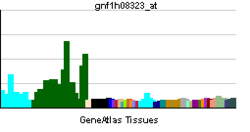RAB11FIP4
| View/Edit Human | View/Edit Mouse |
Rab11 family-interacting protein 4 is a protein that in humans is encoded by the RAB11FIP4 gene.[3][4][5]
Interactions
RAB11FIP4 has been shown to interact with RAB11A.[6]
References
- ↑ "Human PubMed Reference:".
- ↑ "Mouse PubMed Reference:".
- ↑ Nagase T, Nakayama M, Nakajima D, Kikuno R, Ohara O (May 2001). "Prediction of the coding sequences of unidentified human genes. XX. The complete sequences of 100 new cDNA clones from brain which code for large proteins in vitro". DNA Res. 8 (2): 85–95. doi:10.1093/dnares/8.2.85. PMID 11347906.
- ↑ Jenne DE, Tinschert S, Reimann H, Lasinger W, Thiel G, Hameister H, Kehrer-Sawatzki H (Aug 2001). "Molecular characterization and gene content of breakpoint boundaries in patients with neurofibromatosis type 1 with 17q11.2 microdeletions". Am J Hum Genet. 69 (3): 516–527. doi:10.1086/323043. PMC 1235482
 . PMID 11468690.
. PMID 11468690. - ↑ "Entrez Gene: RAB11FIP4 RAB11 family interacting protein 4 (class II)".
- ↑ Wallace, Deborah M E; Lindsay Andrew J; Hendrick Alan G; McCaffrey Mary W (Dec 2002). "Rab11-FIP4 interacts with Rab11 in a GTP-dependent manner and its overexpression condenses the Rab11 positive compartment in HeLa cells". Biochem. Biophys. Res. Commun. United States. 299 (5): 770–779. doi:10.1016/S0006-291X(02)02720-1. ISSN 0006-291X. PMID 12470645.
Further reading
- Jenne DE, Tinschert S, Stegmann E, et al. (2000). "A common set of at least 11 functional genes is lost in the majority of NF1 patients with gross deletions". Genomics. 66 (1): 93–97. doi:10.1006/geno.2000.6179. PMID 10843809.
- Wallace DM, Lindsay AJ, Hendrick AG, McCaffrey MW (2003). "Rab11-FIP4 interacts with Rab11 in a GTP-dependent manner and its overexpression condenses the Rab11 positive compartment in HeLa cells". Biochem. Biophys. Res. Commun. 299 (5): 770–779. doi:10.1016/S0006-291X(02)02720-1. PMID 12470645.
- Strausberg RL, Feingold EA, Grouse LH, et al. (2003). "Generation and initial analysis of more than 15,000 full-length human and mouse cDNA sequences". Proc. Natl. Acad. Sci. U.S.A. 99 (26): 16899–16903. doi:10.1073/pnas.242603899. PMC 139241
 . PMID 12477932.
. PMID 12477932. - Jenne DE, Tinschert S, Dorschner MO, et al. (2003). "Complete physical map and gene content of the human NF1 tumor suppressor region in human and mouse". Genes Chromosomes Cancer. 37 (2): 111–120. doi:10.1002/gcc.10206. PMID 12696059.
- Ota T, Suzuki Y, Nishikawa T, et al. (2004). "Complete sequencing and characterization of 21,243 full-length human cDNAs". Nat. Genet. 36 (1): 40–45. doi:10.1038/ng1285. PMID 14702039.
- Gerhard DS, Wagner L, Feingold EA, et al. (2004). "The status, quality, and expansion of the NIH full-length cDNA project: the Mammalian Gene Collection (MGC)". Genome Res. 14 (10B): 2121–2127. doi:10.1101/gr.2596504. PMC 528928
 . PMID 15489334.
. PMID 15489334. - Fielding AB, Schonteich E, Matheson J, et al. (2006). "Rab11-FIP3 and FIP4 interact with Arf6 and the exocyst to control membrane traffic in cytokinesis". EMBO J. 24 (19): 3389–3399. doi:10.1038/sj.emboj.7600803. PMC 1276165
 . PMID 16148947.
. PMID 16148947. - Lim J, Hao T, Shaw C, et al. (2006). "A protein-protein interaction network for human inherited ataxias and disorders of Purkinje cell degeneration". Cell. 125 (4): 801–814. doi:10.1016/j.cell.2006.03.032. PMID 16713569.
- Douglas J, Cilliers D, Coleman K, et al. (2007). "Mutations in RNF135, a gene within the NF1 microdeletion region, cause phenotypic abnormalities including overgrowth". Nat. Genet. 39 (8): 963–965. doi:10.1038/ng2083. PMID 17632510.
This article is issued from Wikipedia - version of the 6/5/2016. The text is available under the Creative Commons Attribution/Share Alike but additional terms may apply for the media files.

